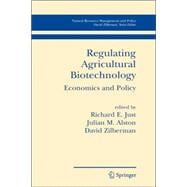
What is included with this book?
| Introduction | |
| Regulating Agricultural Biotechnology: Introduction and Overview | p. 3 |
| Agricultural Biotechnology in the Context of a Regulated Agricultural Sector | |
| Technological Regulation in U.S. Agriculture | |
| Economic Analysis and Regulating Pesticide Biotechnology at the U.S. Environmental Protection Agency | p. 21 |
| Compliance Costs for Regulatory Approval of New Biotech Crops | p. 37 |
| Regulation of Technology in the Context of U.S. Agricultural Policy | p. 59 |
| Managing Liabilities Arising from Agricultural Biotechnology | p. 81 |
| Benefits from Agricultural Biotechnologies | |
| Status of Agricultural Biotechnology: An International Perspective | p. 103 |
| Interactions Between Trade Policies and GM Food Regulations | p. 125 |
| Hidden Benefits of Agricultural Biotechnologies | |
| The Value of Non-Pecuniary Characteristics of Crop Biotechnologies: A New Look at the Evidence | p. 145 |
| Bt Corn's Reduction of Mycotoxins: Regulatory Decisions and Public Opinion | p. 179 |
| Consumer and Market Acceptance of Agricultural Biotechnologies | |
| Consumer Attitudes and Market Resistance to Biotech Products | p. 201 |
| Comparison of Consumer Responses to Genetically Modified Foods in Asia, North America, and Europe | p. 227 |
| Conceptual Issues in Regulating Agricultural Biotechnology | |
| The Causes of Regulations and Their Impacts | |
| The Economics of Biotechnology Regulation | p. 243 |
| Labeling Regulations and Segregation of First- and Second-Generation GM Products: Innovation Incentives and Welfare Effects | p. 263 |
| Environmental Risks of Agricultural Biotechnologies and Regulatory Response | |
| Regulation of Technology in the Context of Risk Generation | p. 283 |
| Environmental Effects of Genetically Modified Crops: Differentiated Risk Assessment and Management | p. 301 |
| Irreversibility, Uncertainty, and the Adoption of Transgenic Crops: Experiences from Applications to HT Sugar Beets, HT Corn, and Bt Corn | p. 327 |
| Imperfect Competition, Political Economy, and Regulation of Agricultural Biotechnologies | |
| Anticompetitive Impacts of Laws That Regulate Commercial Use of Agricultural Biotechnologies in the United States | p. 353 |
| Regulation, Trade, and Market Power: Agricultural Chemical Markets and Incentives for Biotechnology | p. 397 |
| Regulation and the Structure of Biotechnology Industries | p. 421 |
| The Social Welfare Implications of Intellectual Property Protection: Imitation and Going Off Patent | p. 437 |
| Case Studies on the Economics of Regulating Agricultural Biotechnology | |
| International Evidence | |
| International Approval and Labeling Regulations of Genetically Modified Food in Major Trading Countries | p. 459 |
| Benefits and Costs of Biosafety Regulation in India and China | p. 481 |
| Biosafety Regulation of Genetically Modified Orphan Crops in Developing Courntries: A Way Forward | p. 509 |
| Refuge Policy and Regulatory Compliance at the Farm Level | |
| Bt Resistance Management: The Economics of Refuges | p. 535 |
| Managing European Corn Borer Resistance to Bt Corn with Dynamic Refuges | p. 559 |
| Farmer Demand for Corn Rootworm Bt Corn: Do Insect Resistance Management Guidelines Really Matter? | p. 579 |
| Adverse Selection, Moral Hazard, and Grower Compliance with Bt Corn Refuge | p. 599 |
| Damage from Secondary Pests and the Need for Refuge in China | p. 625 |
| Crop-Specific Issues in Biotechnology Regulation | |
| Regulation of Biotechnology for Field Crops | p. 639 |
| Regulation of Transgenic Crops Intended for Pharmaceutical and Industrial Uses | p. 647 |
| Regulation of Biotechnology for Forestry Products | p. 663 |
| Regulation of Biotechnology for Specialty Crops | p. 683 |
| Conclusions | |
| What Have We Learned, and Where Do We Go from Here? | p. 701 |
| Index | p. 723 |
| Table of Contents provided by Ingram. All Rights Reserved. |
The New copy of this book will include any supplemental materials advertised. Please check the title of the book to determine if it should include any access cards, study guides, lab manuals, CDs, etc.
The Used, Rental and eBook copies of this book are not guaranteed to include any supplemental materials. Typically, only the book itself is included. This is true even if the title states it includes any access cards, study guides, lab manuals, CDs, etc.